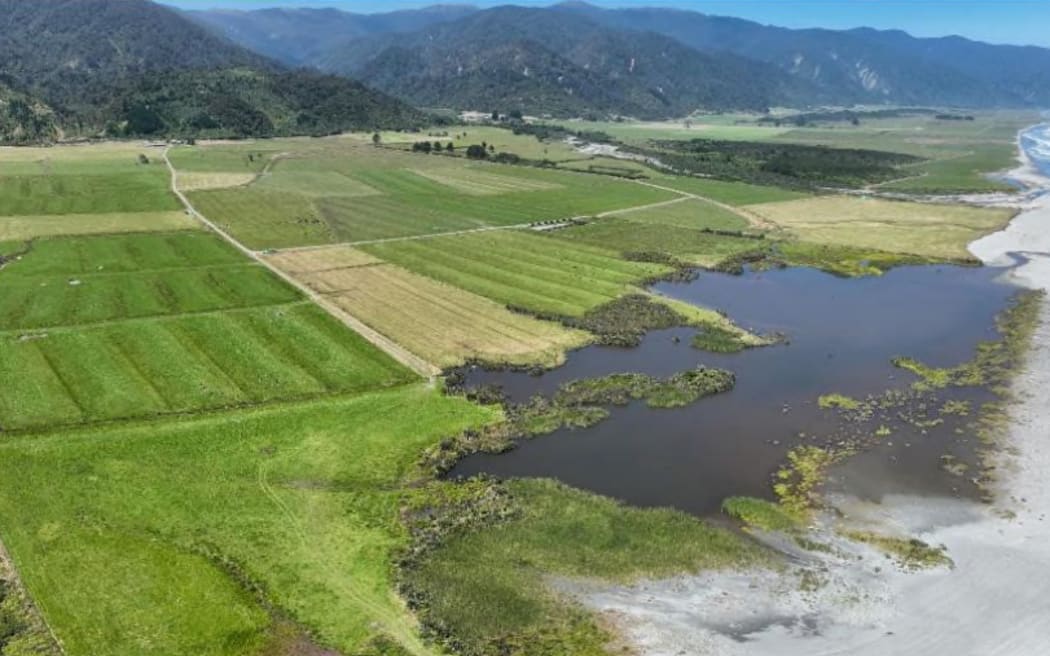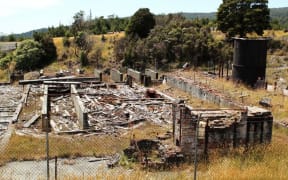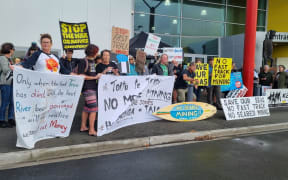
The Tiga mine site looking inland across the current farm run-off towards the Paparoa Range with Collins Creek Lagoon in the foreground showing raupō flax land and partially drowned rushes and sedges on the coastal edge of the lagoon. Photo: Gary Teear via LDR
Australian mining company Tiga has been given the green light to mine mineral sands from 63 hectares of the Barrytown Flats north of Greymouth.
The independent panel of commissioners appointed by the Grey District and West Coast Regional councils on the application released their decision today.
It follows an earlier rejection two years ago of the Tiga proposal by a joint panel of the two councils.

The site is 36km north of Greymouth on about 63ha of coastal flats.
Tiga proposes a 12-year operation.
The 186-page decision with another 32 pages of extensive conditions includes the associated processing plant and associated support facilities on about 2ha of the site.
It will result in "a minimum average" of 50 extra truck movements on the scenic Coast Road (State Highway 6).
The decision notes "an innovative water management system" by Tiga to enable their operation in a coastal site with "a delicate ecological setting".
The panel decision notes seven key matters in contention, raised earlier in the year in a Greymouth hearing.
Four were of the intense ecological importance of the Barrytown Flats reflecting many significant natural areas and delicate ecological relationships.
Two were related to the wetland setback issue from the proposed site. The remaining matters concerned effects on the Coast Road environment, the road users and the measurement of economic benefits from the proposal.
A key matter was the argument about "functional need" for the proposed site under the national environmental standards for freshwater as Tiga wants their mine within the 100m wetland setback of the Canoe Creek coastal lagoon.
The regional council's planning expert Michael Durand controversially argued during the hearings this was not a valid reason.
The commissioners said the argument Tiga did not have a functional need to encroach into the 100 setback was "misguided".
"We consider the constraints and characteristics influencing Tiga's mine design created a 'functional need' to operate within the 100m setback," their decision said.
The impact of mine lighting on the nocturnal flying petrel was the other key consideration.
The Department of Conservation said consent should be declined because of the risk despite a range of mitigation proposals by the applicant.
"The panel does not see how any further measures beyond the offered conditions, such as declining consent, will meaningfully contribute to protecting the Westland Petrel from population-level cumulative effects arising from existing threats and those that foreseeably could arise in the existing environment," the decision said.
Tiga has also confirmed heavy mineral concentrate will be trucked on the Coast Road to either Rapahoe or Stillwater for rail loading.
"We do not consider that the maximum of five additional ... haulage truck movements per hour, six days a week, coupled with the daily morning and evening minibus movements for shift workers, will exacerbate that risk to such a degree that would warrant consent being declined."
The land is currently used as a dairy run-off by Nikau Farm Limited.
Tiga is targeting ilmenite (titanium dioxide) and garnet.
The decision notes the coastal strip for the intended mine is in "a mosaic of natural and cultural resources and activities, including "a complex network of waterways" and surrounded by significant natural heritage supporting " a complex array of ecological relationships".
The commissioners note evidence and concerns from opposing groups including the Coast Road Residents Group about effects on their environment and the director general of the Department of Conservation, principally on Taiko.
The residents' group input had positively impacted the conditions Tiga were prepared to endorse, the commissioners said.
"Undoubtedly, CRRG's contribution to the process prompted many of the proposal's design adjustments reflected in the offered conditions," their decision said.
There had also been "a high degree of agreement" amongst the two council's technical experts, that the proposal's effects could be "managed appropriately by conditions".
LDR is local body journalism co-funded by RNZ and NZ On Air.




